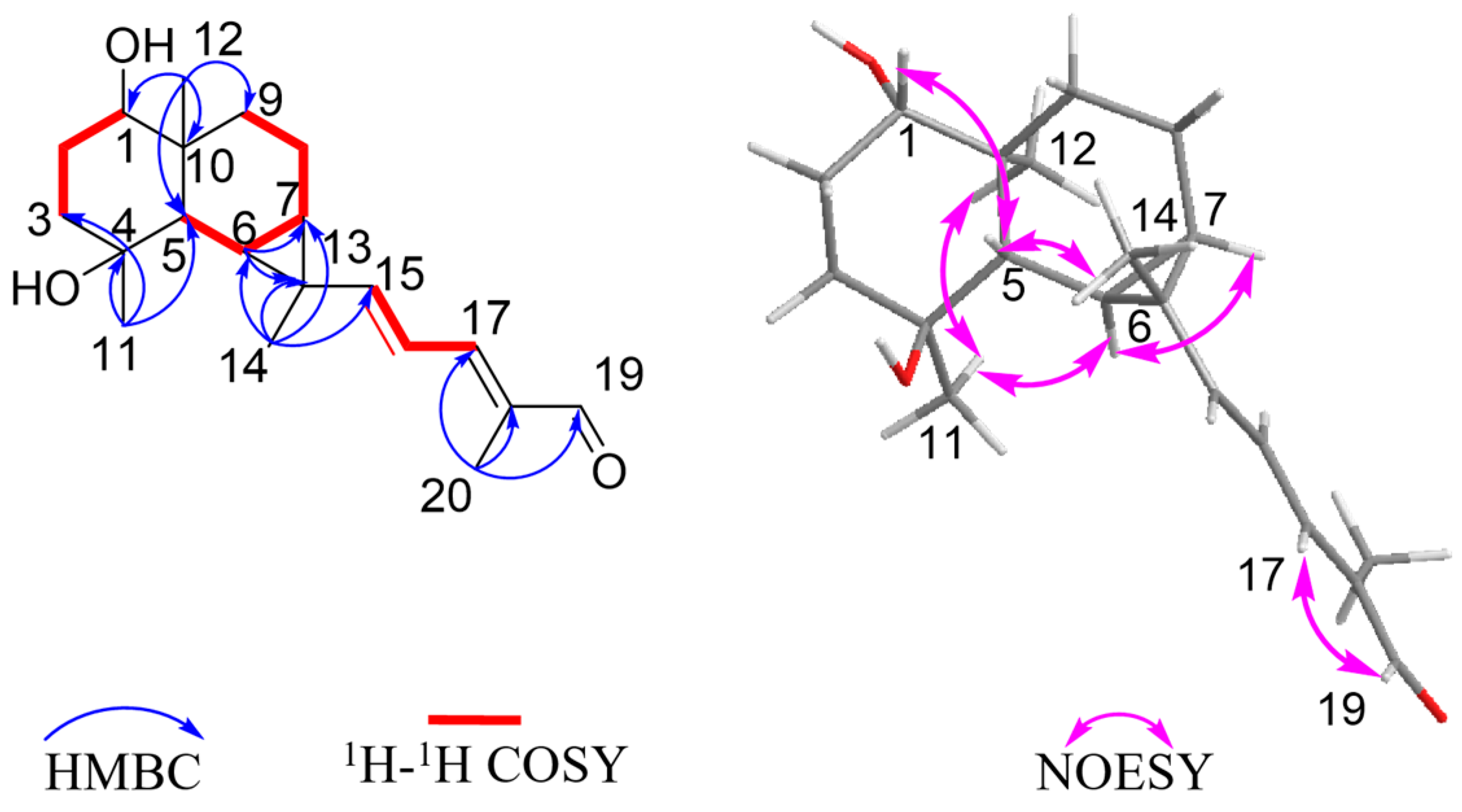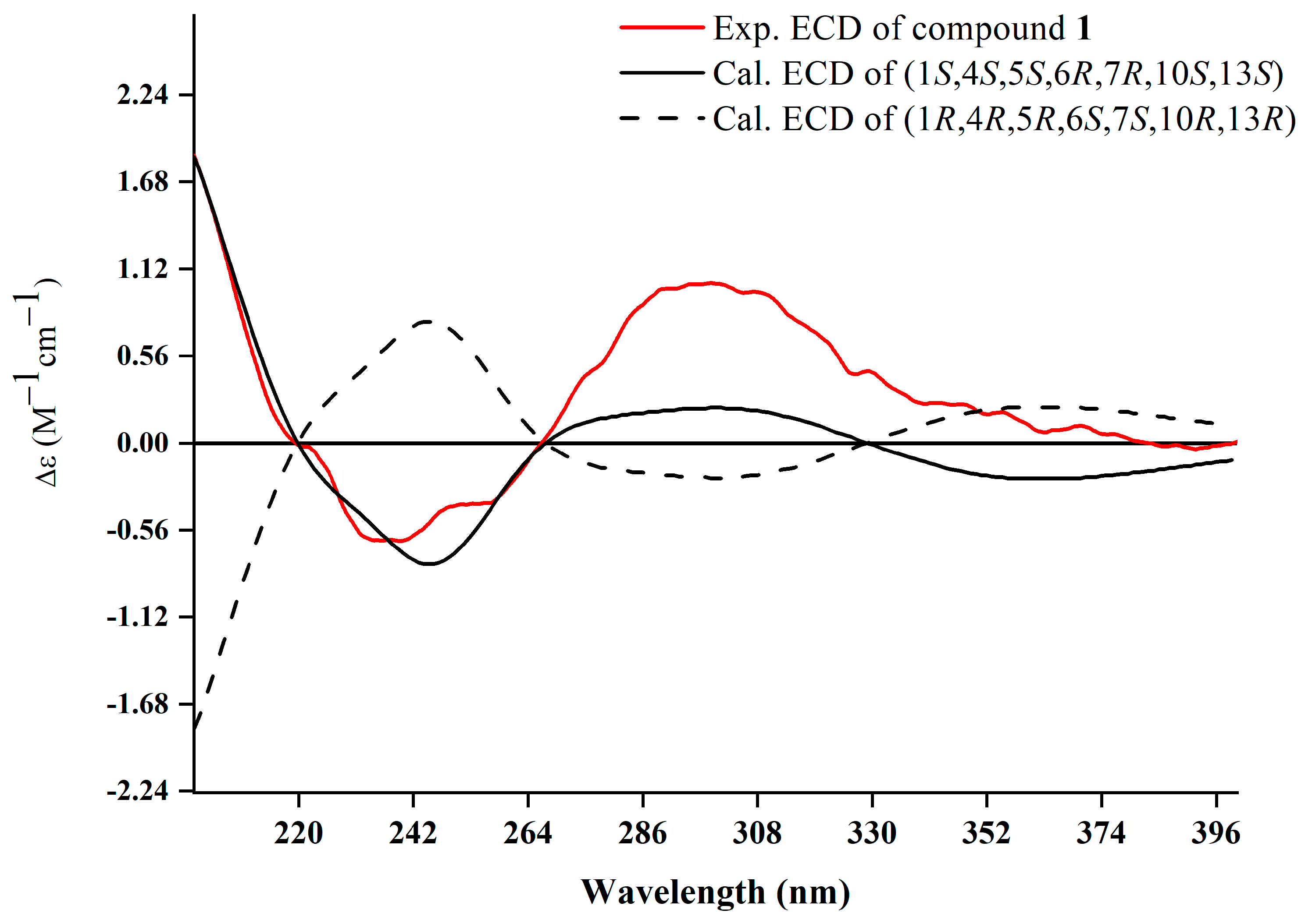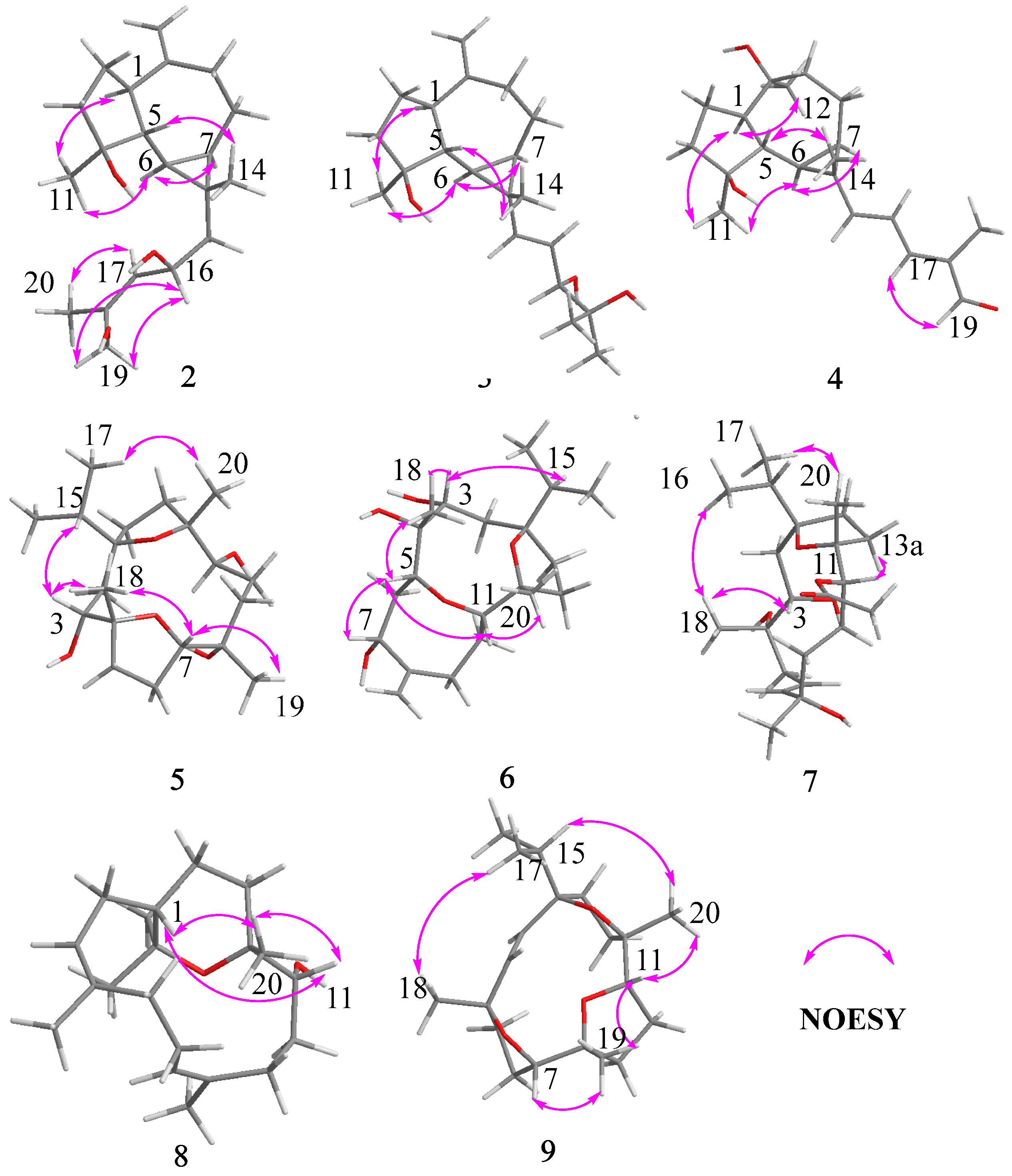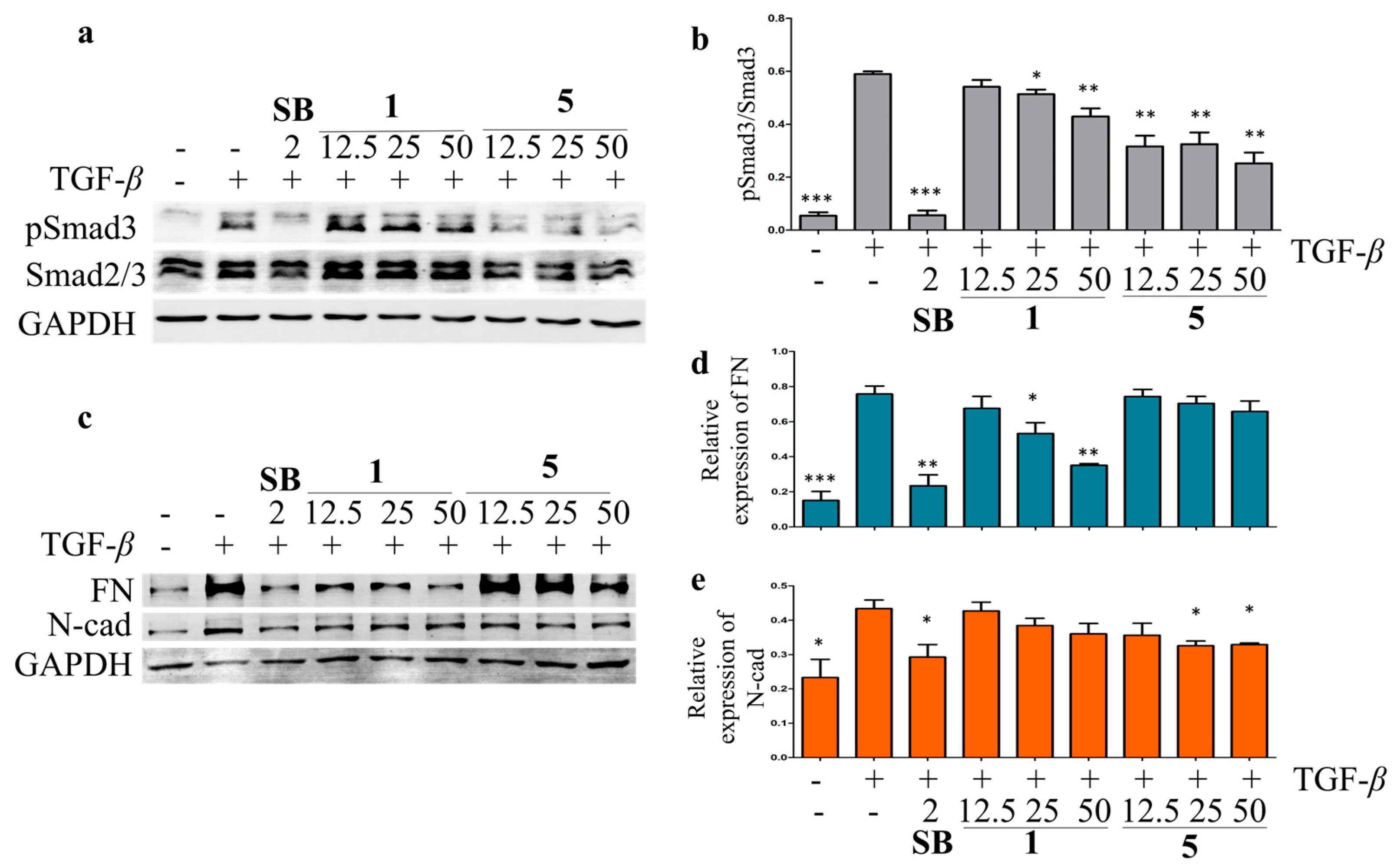Boswellianols A–I, Structurally Diverse Diterpenoids from the Oleo-Gum Resin of Boswellia carterii and Their TGF-β Inhibition Activity
Abstract
:1. Introduction
2. Results and Discussion
2.1. Chemical Constituents from Olibanum of Boswellia carterii
2.2. TGF-β Inhibition Assessments of the Isolated Compounds
3. Material and Method
3.1. General Experimental Procedures
3.2. Plant Resin Material
3.3. Extraction and Isolation
3.4. Cell Lines and Cultures
3.5. Western Blot Analysis
3.6. ECD Calculation
4. Conclusions
Supplementary Materials
Author Contributions
Funding
Data Availability Statement
Acknowledgments
Conflicts of Interest
References
- POWO. Plants of the World Online. Available online: https://powo.science.kew.org/taxon/urn:lsid:ipni.org:names:5117-1 (accessed on 12 December 2023).
- Ojha, P.K.; Poudel, D.K.; Rokaya, A.; Satyal, R.; Setzer, W.N.; Satyal, P. Comparison of Volatile Constituents Present in Commercial and Lab-Distilled Frankincense (Boswellia carteri) Essential Oils for Authentication. Plants 2022, 11, 2134. [Google Scholar] [CrossRef] [PubMed]
- Cao, B.; Wei, X.-C.; Xu, X.-R.; Zhang, H.-Z.; Luo, C.-H.; Feng, B.; Xu, R.-C.; Zhao, S.-Y.; Du, X.-J.; Han, L.; et al. Seeing the Unseen of the Combination of Two Natural Resins, Frankincense and Myrrh: Changes in Chemical Constituents and Pharmacological Activities. Molecules 2019, 24, 3076. [Google Scholar] [CrossRef] [PubMed]
- Gadisa, E.; Weldearegay, G.; Desta, K.; Tsegaye, G.; Hailu, S.; Jote, K.; Takele, A. Combined antibacterial effect of essential oils from three most commonly used Ethiopian traditional medicinal plants on multidrug resistant bacteria. BMC Complement. Altern. Med. 2019, 19, 24. [Google Scholar] [CrossRef]
- Elakkiya, V.; Krishnan, K.; Bhattacharyya, A.; Selvakumar, R. Advances in Ayurvedic medicinal plants and nanocarriers for arthritis treatment and management: A review. J. Her. Med. 2020, 24, 100412. [Google Scholar] [CrossRef]
- Abolhasanzadeh, Z.; Ashrafi, H.; Badr, P.; Azadi, A. Traditional neurotherapeutics approach intended for direct nose to brain delivery. J. Ethnopharmacol. 2017, 209, 116–123. [Google Scholar] [CrossRef]
- Eltahir, H.M.; Fawzy, M.A.; Mohamed, E.M.; Alrehany, M.A.; Shehata, A.M.; Abouzied, M.M. Antioxidant, anti-inflammatory and anti-fibrotic effects of Boswellia serrate gum resin in CCl4-induced hepatotoxicity. Exp. Ther. Med. 2020, 19, 1313–1321. [Google Scholar] [CrossRef]
- Latella, G.; Sferra, R.; Vetuschi, A.; Zanninelli, G.; D’Angelo, A.; Catitti, V.; Caprilli, R.; Gaudio, E. Prevention of colonic fibrosis by Boswellia and Scutellaria extracts in rats with colitis induced by 2,4,5-trinitrobenzene sulphonic acid. Eur. J. Clin. Investig. 2008, 38, 410–420. [Google Scholar] [CrossRef] [PubMed]
- Sferra, R.; Vetuschi, A.; Catitti, V.; Ammanniti, S.; Pompili, S.; Melideo, D.; Frieri, G.; Gaudio, E.; Latella, G. Boswellia serrata and Salvia miltiorrhiza extracts reduce DMN-induced hepatic fibrosis in mice by TGF-β1 downregulation. Eur. Rev. Med. Pharmacol. Sci. 2012, 16, 1484–1498. [Google Scholar]
- Shen, Y.; Takahashi, M.; Byun, H.-M.; Link, A.; Sharma, N.; Balaguer, F.; Leung, H.-C.; Boland, C.R.; Goel, A. Boswellic acid induces epigenetic alterations by modulating DNA methylation in colorectal cancer cells. Cancer Biol. Ther. 2012, 13, 542–552. [Google Scholar] [CrossRef]
- Vuddanda, P.R.; Singh, S.; Velaga, S. Boswellic acid—Medicinal use of an ancient herbal remedy. J. Her. Med. 2016, 6, 163–170. [Google Scholar] [CrossRef]
- Liu, M.; Chen, P.; Büchele, B.; Dong, S.; Huang, D.; Ren, C.; Zhang, Y.; Hou, X.; Simmet, T.; Shen, J. A boswellic acid-containing extract attenuates hepatic granuloma in C57BL/6 mice infected with Schistosoma japonicum. Parasitol. Res. 2013, 112, 1105–1111. [Google Scholar] [CrossRef]
- Liu, M.; Liu, T.; Shang, P.; Zhang, Y.; Liu, L.; Liu, T.; Sun, S. Acetyl-11-keto-β-boswellic acid ameliorates renal interstitial fibrosis via Klotho/TGF-β/Smad signalling pathway. J. Cell. Mol. Med. 2018, 22, 4997–5007. [Google Scholar] [CrossRef] [PubMed]
- Zhang, Y.; Ning, Z.; Lu, C.; Zhao, S.; Wang, J.; Liu, B.; Xu, X.; Liu, Y. Triterpenoid resinous metabolites from the genus Boswellia: Pharmacological activities and potential species-identifying properties. Chem. Cent. J. 2013, 7, 153. [Google Scholar] [CrossRef] [PubMed]
- Al-Harrasi, A.; Avula, S.K.; Csuk, R.; Das, B. Cembranoids from Boswellia species. Phytochemistry 2021, 191, 112897. [Google Scholar] [CrossRef] [PubMed]
- Wang, Y.-G.; Ren, J.; Wang, A.-G.; Yang, J.-B.; Ji, T.-F.; Ma, Q.-G.; Tian, J.; Su, Y.-L. Hepatoprotective Prenylaromadendrane-Type Diterpenes from the Gum Resin of Boswellia carterii. J. Nat. Prod. 2013, 76, 2074–2079. [Google Scholar] [CrossRef] [PubMed]
- Yu, J.; Geng, Y.; Zhao, H.; Wang, X. Diterpenoids from the gum resin of Boswellia carterii and their biological activities. Tetrahedron 2018, 74, 5858–5866. [Google Scholar] [CrossRef]
- Sun, X.; Geng, Y.; Wang, X.; Qin, D.; Yu, J. Cembrane-type diterpenoids from the gum resin of Boswellia carterii and their biological activities. RSC Adv. 2020, 10, 746–755. [Google Scholar] [CrossRef]
- Wang, Y.-g.; Ren, J.; Ma, J.; Yang, J.-b.; Ji, T.; Wang, A.-g. Bioactive cembrane-type diterpenoids from the gum-resin of Boswellia carterii. Fitoterapia 2019, 137, 104263. [Google Scholar] [CrossRef] [PubMed]
- Guo, F.; Zhao, L.; Zhang, K.; Wang, X.; Yu, J. Anti-inflammatory and hepatoprotective cembranes from the gum resin of Boswellia carterii. Phytochem. Lett. 2021, 46, 6–10. [Google Scholar] [CrossRef]
- Pollastro, F.; Golin, S.; Chianese, G.; Putra, M.Y.; Schiano Moriello, A.; De Petrocellis, L.; García, V.; Munoz, E.; Taglialatela-Scafati, O.; Appendino, G. Neuroactive and Anti-inflammatory Frankincense Cembranes: A Structure–Activity Study. J. Nat. Prod. 2016, 79, 1762–1768. [Google Scholar] [CrossRef]
- Wang, J.-J.; Suo, X.-Y.; Sun, H.-R.; Wang, X.; Lin, M.-B.; Wang, J.-H.; Jiang, J.-D.; Ji, T.-F. Prenylaromadendrane-type diterpenoids from the gum resin of Boswellia sacra flueck and their cytotoxic effects. Nat. Prod. Res. 2022, 36, 5400–5406. [Google Scholar] [CrossRef] [PubMed]
- Yuan, Z.; Liu, D.; Zhang, B.; Cao, S.; Yao, T.; Zhao, Q.; Qiu, F.; Zhao, F. New verticillane-diterpenoid as potent NF-κB inhibitor isolated from the gum resin of Boswellia sacra. Fitoterapia 2023, 166, 105460. [Google Scholar] [CrossRef] [PubMed]
- Chen, F.L.; Liu, D.L.; Fu, J.; Yang, J.; Bai, L.P.; Zhang, W.; Jiang, Z.H.; Zhu, G.Y. (±)-Atrachinenins A–C, Three Pairs of Caged C27 Meroterpenoids from the Rhizomes of Atractylodes chinensis. Chin. J. Chem. 2022, 40, 460–466. [Google Scholar] [CrossRef]
- Liu, X.; Fu, J.; Shen, R.-S.; Wu, X.-J.; Yang, J.; Bai, L.-P.; Jiang, Z.-H.; Zhu, G.-Y. Linderanoids A–O, dimeric sesquiterpenoids from the roots of Lindera aggregata (Sims) Kosterm. Phytochemistry 2021, 191, 112924. [Google Scholar] [CrossRef] [PubMed]
- Wu, X.-J.; Cao, D.; Chen, F.-L.; Shen, R.-S.; Gao, J.; Bai, L.-P.; Zhang, W.; Jiang, Z.-H.; Zhu, G.-Y. Chlorfortunones A and B, Two Sesquiterpenoid Dimers, Possessing Dispiro[4,2,5,2]pentadecane-6,10,14-tren Moiety from Chloranthus fortunei. ACS Omega 2022, 7, 35063–35068. [Google Scholar] [CrossRef] [PubMed]
- Ren, J.; Wang, Y.-G.; Wang, A.-G.; Wu, L.-Q.; Zhang, H.-J.; Wang, W.-J.; Su, Y.-L.; Qin, H.-L. Cembranoids from the Gum Resin of Boswellia carterii as Potential Antiulcerative Colitis Agents. J. Nat. Prod. 2015, 78, 2322–2331. [Google Scholar] [CrossRef] [PubMed]
- Brochini, C.B.; Roque, N.F. Two new cneorubin related diterpenes from the leaves of Guarea guidonia (Meliaceae). J. Braz. Chem. Soc. 2000, 11, 361–364. [Google Scholar] [CrossRef]
- Kitajima, J.; Kimizuka, K.; Tanak, Y. Three new sesquiterpenoid glucosides of Ficus pumila fruit. Chem. Pharm. Bull. 2000, 48, 77–80. [Google Scholar] [CrossRef]
- Feng, Y.; Zhang, Q.; Sun, L. Five terpenoids from the gum resin of Boswellia carterii and their cytotoxicity. Fitoterapia 2021, 154, 105017. [Google Scholar] [CrossRef]
- Xu, B.; Li, Z.; Alsup, T.A.; Ehrenberger, M.A.; Rudolf, J.D. Bacterial diterpene synthases prenylate small molecules. ACS Catal. 2021, 11, 5906–5915. [Google Scholar] [CrossRef]
- Li, H.; Dickschat, J.S. Diterpene Biosynthesis from Geranylgeranyl Diphosphate Analogues with Changed Reactivities Expands Skeletal Diversity. Angew. Chem. Int. Ed. 2022, 61, e202211054. [Google Scholar] [CrossRef] [PubMed]
- Durán-Peña, M.J.; Botubol Ares, J.M.; Hanson, J.R.; Collado, I.G.; Hernández-Galán, R. Biological activity of natural sesquiterpenoids containing a gem-dimethylcyclopropane unit. Nat. Prod. Rep. 2015, 32, 1236–1248. [Google Scholar] [CrossRef] [PubMed]
- Hackl, T.; König, W.A.; Muhle, H. Isogermacrene A, a proposed intermediate in sesquiterpene biosynthesis. Phytochemistry 2004, 65, 2261–2275. [Google Scholar] [CrossRef] [PubMed]
- Rahelivao, M.P.; Gruner, M.; Lübken, T.; Islamov, D.; Kataeva, O.; Andriamanantoanina, H.; Bauer, I.; Knölker, H.-J. Chemical constituents of the soft corals Sinularia vanderlandi and Sinularia gravis from the coast of Madagascar. Org. Biomol. Chem. 2016, 14, 989–1001. [Google Scholar] [CrossRef] [PubMed]
- Carmely, S.; Groweiss, A.; Kashman, Y. Decaryiol, a new cembrane diterpene from the marine soft coral Sarcophyton decaryi. J. Org. Chem. 1981, 46, 4279–4284. [Google Scholar] [CrossRef]
- Dhar, D.; Baglieri, J.; Kisseleva, T.; Brenner, D.A. Mechanisms of liver fibrosis and its role in liver cancer. Exp. Biol. Med. 2020, 245, 96–108. [Google Scholar] [CrossRef] [PubMed]
- Kisseleva, T.; Brenner, D. Molecular and cellular mechanisms of liver fibrosis and its regression. Nat. Rev. Gastroenterol. Hepatol. 2021, 18, 151–166. [Google Scholar] [CrossRef] [PubMed]
- Chen, F.-L.; Liu, D.-L.; Fu, J.; Fu, L.; Gao, J.; Bai, L.-P.; Zhang, W.; Jiang, Z.-H.; Zhu, G.-Y. Atrachinenynes A–D, four diacetylenic derivatives with unprecedented skeletons from the rhizomes of Atractylodes chinensis. New J. Chem. 2022, 46, 15530–15537. [Google Scholar] [CrossRef]
- Ren, W.-J.; Io, C.-C.; Jiang, R.; Ng, K.-F.; Liu, J.-Z.; Bai, L.-P.; Zhang, W.; Jiang, Z.-H.; Liu, Y.-H.; Zhu, G.-Y. Di- and Triterpenoids from the Rhizomes of Isodon amethystoides and Their Anti-inflammatory Activities. J. Nat. Prod. 2023, 86, 1230–1239. [Google Scholar] [CrossRef]







| No. | 1 | 2 | 3 | 4 |
|---|---|---|---|---|
| 1 | 3.30, dd, (11.5, 4.4) | 2.26, m | 2.22, td, (16.0, 6.0) | 1.91, overlap |
| 2 | 1.62, m 1.79, m | 1.66, m 1.93, m | 1.65, m 1.92, m | 1.70, m 1.92, overlap |
| 3 | 1.53, d, (3.43) 1.84, overlap | 1.67, m 1.74, m | 1.58, m 1.78, m | 1.58, m 1.80, dd |
| 5 | 1.14, m | 1.35, t, (10.7) | 1.44, t, (10.9) | 1.40, t, (10.5) |
| 6 | 1.20, overlap | 0.61, t, (10.2) | 0.80, dd, (11.2, 9.6) | 0.98, t, (10.2) |
| 7 | 1.07, m | 0.84, td, (10.3, 6.3) | 1.06, q, (5.2) | 1.17, dd, (10.1, 3.8) |
| 8 | 1.70, m 1.93, m | 1.03, m 2.03, m | 1.07, overlap 2.03, overlap | 1.09, m 1.92, overlap |
| 9 | 0.83, m 1.78, m | 2.01, m 2.44, m | 2.06, overlap 2.45, q, (6.5) | 1.62, m 1.68, m |
| 11 | 1.31, s | 1.28, s | 1.22, s | 1.23, s |
| 12 | 0.92, s | 4.70, s 4.72, s | 4.69, s 4.72, s | 1.22, s |
| 14 | 1.19, s | 1.10, s | 1.18, s | 1.29, s |
| 15 | 5.80, d, (15.0) | 1.44, m 1.57, m | 5.36, d, (15.9) | 5.79, d, (15.1) |
| 16 | 6.43, dd, (15.0, 11.1) | 4.69, overlap | 5.41, d, (15.5, 7.6) | 6.45, dd, (15.1, 11.1) |
| 17 | 6.80, d, (11.1) | 5.34, d, (8.0) | 3.84, d, (7.6) | 6.80, d, (11.1) |
| 19 | 9.38, s | 4.21, d, (12.2) 4.08, d, (12.1) | 1.15, s | 9.38, s |
| 20 | 1.84, s | 1.82, s | 1.19, s | 1.84, s |
| No. | 1 | 2 | 3 | 4 | 5 | 6 | 7 | 8 | 9 |
|---|---|---|---|---|---|---|---|---|---|
| 1 | 78.3 CH | 50.6 CH | 53.2 CH | 55.6 CH | 88.9 C | 87.7 C | 89.0 C | 49.7 CH | 86.4 C |
| 2 | 25.2 CH2 | 25.2 CH2 | 26.8 CH2 | 23.7 CH2 | 38.9 CH2 | 38.9 CH2 | 35.4 CH2 | 30.7 CH2 | 132.8 CH |
| 3 | 40.1 CH2 | 41.2 CH2 | 41.8 CH2 | 43.7 CH2 | 72.8 CH | 74.4 CH | 71.0 CH2 | 125.0 CH | 130.1 CH |
| 4 | 72.1 C | 80.7 C | 80.9 C | 80.2 C | 84.8 C | 76.7 C | 75.1 C | 134.5 C | 73.3 C |
| 5 | 47.4 CH | 53.1 CH | 53.5 CH | 47.3 CH | 36.9 CH2 | 86.1 CH | 42.5 CH2 | 38.9 CH2 | 38.5 CH2 |
| 6 | 22.4 CH | 25.6 CH | 31.0 CH | 31.3 CH | 27.6 CH2 | 38.7 CH2 | 123.0 CH | 24.3 CH2 | 26.6 CH2 |
| 7 | 24.0 CH | 27.6 CH | 28.7 CH | 29.5 CH | 85.5 CH | 75.6 CH | 140.2 CH | 124.2 CH | 82.5 CH |
| 8 | 15.2 CH2 | 24.8 CH2 | 24.2 CH2 | 19.7 CH2 | 74.7 C | 152.5 C | 73.7 C | 135.2 C | 86.3 C |
| 9 | 36.9 CH2 | 38.7 CH2 | 38.6 CH2 | 41.2 CH2 | 33.9 CH2 | 26.9 CH2 | 23.1 CH2 | 39.2 CH2 | 36.4 CH2 |
| 10 | 38.0 C | 153.5 C | 152.8 C | 75.2 C | 27.4 CH2 | 32.4 CH2 | 38.8 CH2 | 28.1 CH2 | 28.0 CH2 |
| 11 | 23.2 CH3 | 24.5 CH3 | 26.1 CH3 | 24.4 CH3 | 77.3 CH | 86.9 CH | 78.8 CH | 72.9 CH | 83.1 CH |
| 12 | 13.4 CH3 | 106.6 CH2 | 106.9 CH2 | 20.3 CH3 | 85.1 C | 85.7 C | 84.5 C | 75.1 C | 86.1 C |
| 13 | 25.7 C | 21.6 C | 26.0 C | 27.4 C | 37.8 CH2 | 29.6 CH2 | 35.4 CH2 | 38.8 CH2 | 30.5 CH2 |
| 14 | 11.1 CH3 | 14.8 CH3 | 12.7 CH3 | 12.3 CH3 | 29.9 CH2 | 29.9 CH2 | 32.3 CH2 | 24.8 CH2 | 27.7 CH2 |
| 15 | 156.5 CH | 50.0 CH2 | 144.9 CH | 155.9 CH | 32.3 CH | 32.3 CH | 34.1 CH | 74.5 C | 36.9 CH |
| 16 | 120.3 CH | 66.3 CH | 122.6 CH | 120.3 CH | 16.6 CH3 | 16.7 CH3 | 17.5 CH3 | 25.9 CH3 | 17.0 CH3 |
| 17 | 150.0 CH | 131.1 CH | 80.2 CH | 149.9 CH | 18.9 CH3 | 19.3 CH3 | 18.0 CH3 | 29.5 CH3 | 18.4 CH3 |
| 18 | 134.8 C | 138.7 C | 72.8 C | 135.0 C | 20.3 CH3 | 14.0 CH3 | 23.7 CH3 | 15.6 CH3 | 31.3 CH3 |
| 19 | 195.0 CH | 62.1 CH2 | 23.7 CH3 | 195.0 CH | 29.5 CH3 | 116.2 CH2 | 29.5 CH3 | 17.6 CH3 | 19.0 CH3 |
| 20 | 9.4 CH3 | 22.0 CH3 | 26.4 CH3 | 9.4 CH3 | 20.1 CH3 | 25.4 CH3 | 22.4 CH3 | 24.4 CH3 | 25.2 CH3 |
| AcO | 171.3 C | ||||||||
| 21.2 CH3 |
| No. | 5 | 6 | 7 | 8 | 9 |
|---|---|---|---|---|---|
| 1 | 1.50, m | ||||
| 2 | 1.56, t, (4.8) 1.99, m | 1.54, m 2.20, dd, (15.0, 3.9) | 1.66, overlap 1.69, overlap | 1.72, overlap 2.12, overlap | 5.55, d, (16.3) |
| 3 | 3.81, d, (7.2) | 3.75, dd, (3.3, 2.6) | 3.67, dd, (8.5, 2.5) | 5.12, dd, (8.3, 4.6) | 5.23, d, (16.3) |
| 5 | 1.73, overlap 2.22, overlap | 3.21, d, (10.0) | 2.48, ddd, (12.4, 7.2, 1.3) 2.30, dd, (14.4, 6.5) | 2.13, overlap 2.25, overlap | 1.57, q, (7.7) 1.93, m |
| 6 | 1.73, overlap 2.28, overlap | 1.92, td, (13.6, 10.4) 2.32, dd, (13.7, 5.1) | 5.56, td, (15.7, 6.9) | 2.13, overlap 2.25, overlap | 1.23, m 1.29, m |
| 7 | 3.90, dd, (10.6, 5.0) | 4.30, dd, (10.6, 4.7) | 5.77, td, (15.9, 1.4) | 5.05, t, (5.34) | 3.35, d, (8.9) |
| 9 | 1.63, m 1.80, m | 2.22, m 2.40, m | 1.64, overlap 1.74, m | 2.16, overlap 2.31, t, (7.3) | 1.65, m 1.76, overlap |
| 10 | 1.85, overlap 2.10, overlap | 1.44, m 1.56, m | 1.41, m 1.64, overlap | 1.47, m 1.79, m | 1.64, m 2.21, dd, (3.8, 1.4) |
| 11 | 4.25, dd, (11.4, 2.7) | 3.27, dd, (11.4, 2.6) | 4.88, dd, (11.0, 2.2) | 3.96, t, (7.4) | 4.12, dd, (9.5, 3.0) |
| 13 | 1.84, overlap 2.12, overlap | 1.37, (12.2, 7.9) 2.09, td, (12.4, 7.6) | 1.66, overlap 1.78, m | 1.65, m 1.73, m | 1.44, m 1.85, m |
| 14 | 1.44, dd, (11.4, 2.0) 2.16, dd, (13.9, 7.1) | 1.31, (11.9, 7.6) 1.77, td, (12.3, 8.0) | 1.65, overlap 1.97, m | 2.00, m 2.06, m | 1.77, overlap 1.97, m |
| 15 | 2.15, t, (6.2) | 2.02, t, (7.0) | 2.06, overlap | - | 1.79, overlap |
| 16 | 0.94, d, (6.8) | 0.94, d, (6.9) | 0.91, d, (6.8) | 1.19, s | 0.88, d, (6.9) |
| 17 | 0.90, d, (6.8) | 0.95, d, (6.9) | 0.86, d, (6.8) | 1.26, s | 0.83, d, (6.9) |
| 18 | 1.18, s | 1.16, s | 1.28, s | 1.55, s | 1.31, s |
| 19 | 1.16, s | 5.05, s 5.30, s | 1.30, s | 1.64, s | 1.08, s |
| 20 | 1.12, s | 1.02, s | 1.17, s | 1.18, s | 1.07, s |
| AcO | 2.07, s |
Disclaimer/Publisher’s Note: The statements, opinions and data contained in all publications are solely those of the individual author(s) and contributor(s) and not of MDPI and/or the editor(s). MDPI and/or the editor(s) disclaim responsibility for any injury to people or property resulting from any ideas, methods, instructions or products referred to in the content. |
© 2024 by the authors. Licensee MDPI, Basel, Switzerland. This article is an open access article distributed under the terms and conditions of the Creative Commons Attribution (CC BY) license (https://creativecommons.org/licenses/by/4.0/).
Share and Cite
Lin, Z.-R.; Bao, M.-Y.; Xiong, H.-M.; Cao, D.; Bai, L.-P.; Zhang, W.; Chen, C.-Y.; Jiang, Z.-H.; Zhu, G.-Y. Boswellianols A–I, Structurally Diverse Diterpenoids from the Oleo-Gum Resin of Boswellia carterii and Their TGF-β Inhibition Activity. Plants 2024, 13, 1074. https://doi.org/10.3390/plants13081074
Lin Z-R, Bao M-Y, Xiong H-M, Cao D, Bai L-P, Zhang W, Chen C-Y, Jiang Z-H, Zhu G-Y. Boswellianols A–I, Structurally Diverse Diterpenoids from the Oleo-Gum Resin of Boswellia carterii and Their TGF-β Inhibition Activity. Plants. 2024; 13(8):1074. https://doi.org/10.3390/plants13081074
Chicago/Turabian StyleLin, Zhi-Rong, Meng-Yu Bao, Hao-Ming Xiong, Dai Cao, Li-Ping Bai, Wei Zhang, Cheng-Yu Chen, Zhi-Hong Jiang, and Guo-Yuan Zhu. 2024. "Boswellianols A–I, Structurally Diverse Diterpenoids from the Oleo-Gum Resin of Boswellia carterii and Their TGF-β Inhibition Activity" Plants 13, no. 8: 1074. https://doi.org/10.3390/plants13081074






